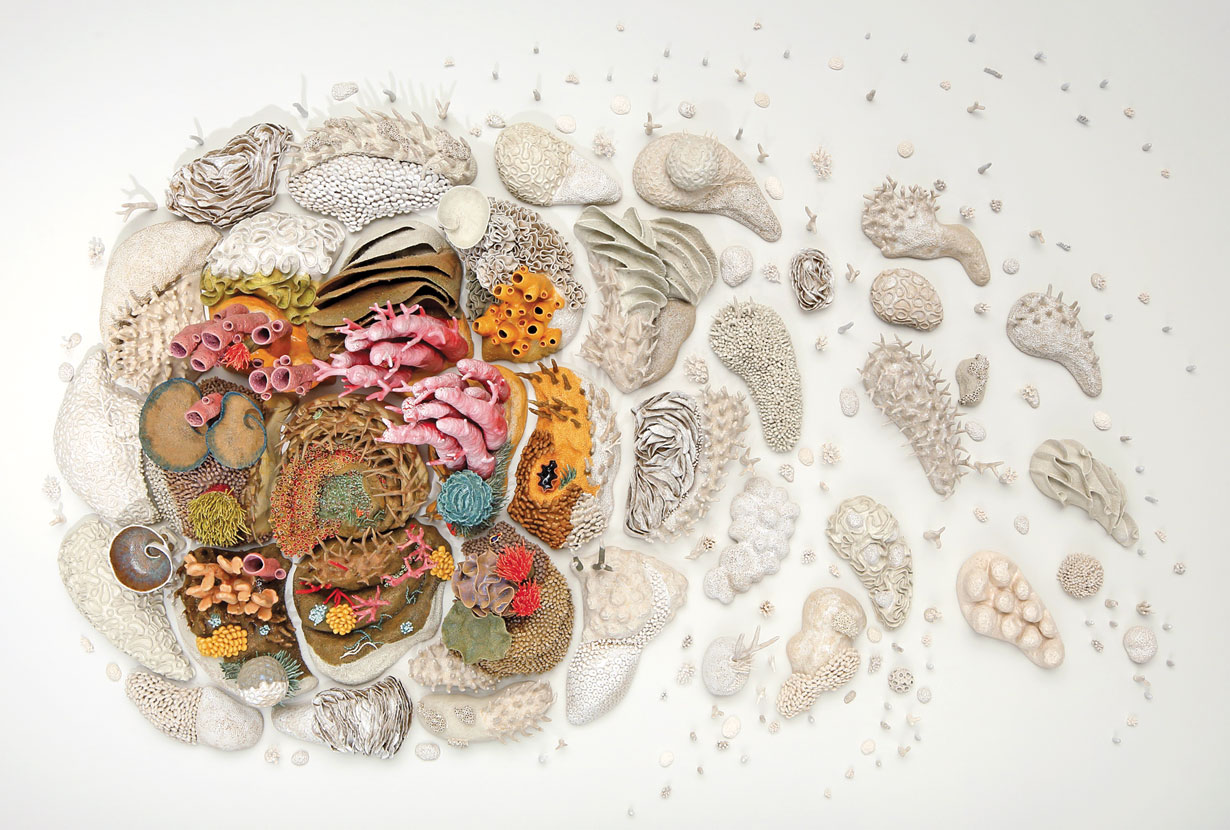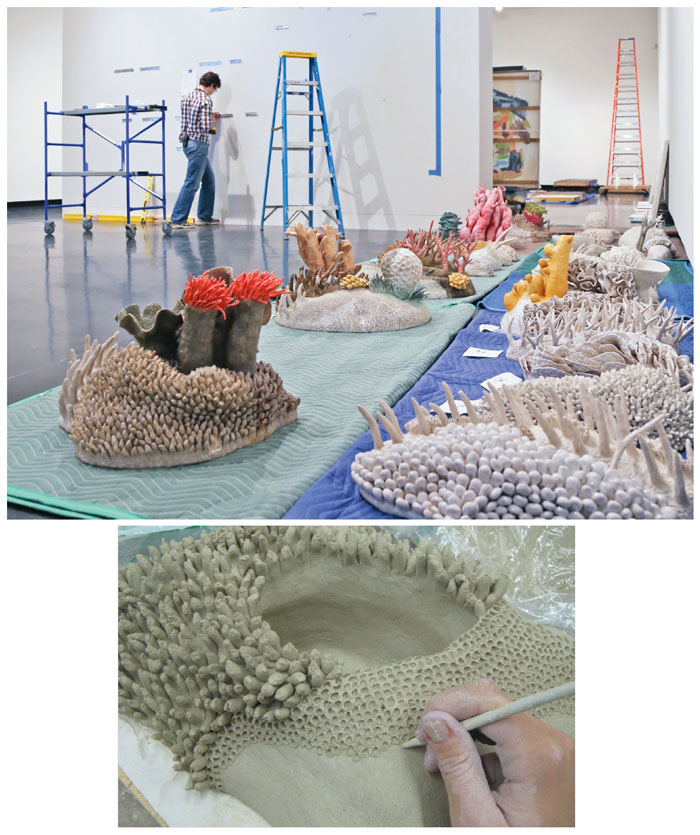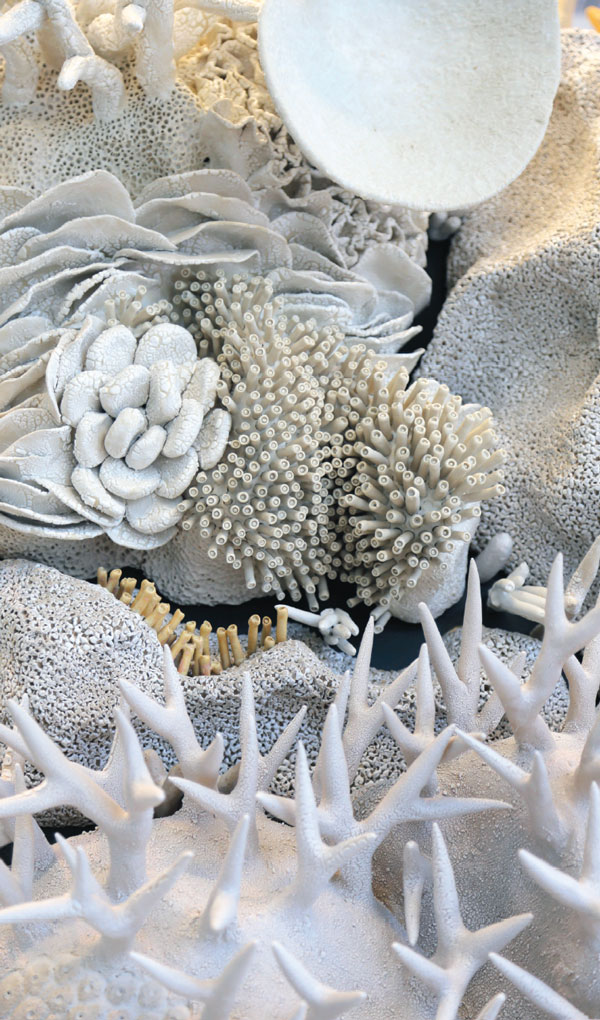Sculpting the Beauty and Peril of Coral Reefs
By Courtney Mattison
A ceramic sculptor brings ocean conservation issues to the surface.
A ceramic sculptor brings ocean conservation issues to the surface.

DOI: 10.1511/2015.115.292
Tropical coral reefs have mesmerized me for as long as I can remember. I am happiest when the exotic forms, vibrant colors, and often venomous appendages of coral reef flora and fauna dance through the window of my scuba mask as I slowly hover nearby—a scene Jacques Cousteau described as “a living kaleidoscope of lilac flecks, splashes of gold, reddish streaks, and yellows, all tinged by the familiar transparent blue of the sea.” Perhaps it’s because I’m relatively small and I respect small creatures that can build big, beautiful things, but I feel that I relate to corals (arguably one of the least relatable animals) on a very deep level.

Photograph by Arthur Evans.
My sense of connection with corals means that I am also profoundly saddened by their demise. Our carbon dioxide (CO2) emissions are making seawater warmer and more acidic, two of the most devastating threats to the health of coral reefs. By now it is well known that reef-building corals offer an early warning on climate change and ocean acidification; they are so sensitive that the slightest alteration to the temperature or chemistry of the seawater that surrounds them can cause total devastation through coral bleaching, erosion, and mortality. Under the stress of warmer seawater, corals expel the colorful symbiotic dinoflagellates called Symbiodinium that live within their tissues; in turn, without the dinoflagellates’ photosynthesis to feed them, corals can starve and die. Malignant algae then smother their skeletons and prevent juvenile corals from repopulating the reef. As the ocean absorbs increasing amounts of atmospheric CO2, the concentration of carbonate ions in seawater dwindles and limits the ability of corals and other calcifying organisms to precipitate their stony skeletons and shells—a phenomenon similar to osteoporosis. Ocean acidification, which Jane Lubchenco, former administrator of the National Oceanic and Atmospheric Administration (NOAA), has called climate change’s “equally evil twin,” may exacerbate coral bleaching as well as algal domination.
Corals are so threatened by our greenhouse gas emissions, pollution, and overfishing that these combined stressors will spell certain disaster for the reefs of the world unless we act now to mitigate our impacts. Leading researchers agree that without swift and effective action, reefs may cease to function as ecological cradles for marine life as soon as the end of this century.
Are coral reefs doomed to fade into oblivion or will we allow them to recover and regain their vibrancy? We won’t act unless we care, and we won’t care if we don’t know. We especially won’t care if we remain unaware of the vast resources and inherent value of reefs that make them important to every human on Earth.
As an “artivist” (artist + activist) with a background in marine conservation ecology, I believe that art touches our emotions and can move us to value the planet we live on in ways that scientific data often cannot.

Photographs by Courtney Mattison.
My work consists of hand-building enormous and intricately detailed ceramic sculptural works inspired by the fragile beauty of reefs and the human-caused threats they face. I often feel like a coral myself, using simple tools such as chopsticks and paintbrushes to methodically construct and texture large, delicate, stony structures.
It feels essential that the medium of my work be ceramic, as calcium carbonate is both the substance of coral skeletons and a common ceramic glaze ingredient. Not only does the chemical structure of my work parallel that of a natural reef, but brittle porcelain anemone tentacles and coral branches break easily if improperly handled, just as the delicate bodies of living reef organisms do. This shared fragility is fundamental to the message of my work.
Combining science and art has always felt natural to me. I am a three-dimensional learner and discovered in high school that it was difficult for me to fully comprehend the anatomy of organisms I studied without sculpting them. Before I became a master’s candidate in environmental studies at Brown University in 2009, I had already realized that approaching marine conservation as an artist and ceramic sculpture as a scientist could produce projects and ideas that are greater than the sum of their parts. For my master’s thesis, therefore, I decided to create a monument to the plight of coral reefs to advocate for environmental stewardship and policy change.

Photograph by Courtney Mattison.
I interviewed 25 of my heroes in the fields of marine research, environmental art, and ocean conservation to learn their thoughts on the potential for art to inspire coral-reef protection. Their responses informed the design of my first large-scale construction of a coral reef, a ceramic wall installation titled Our Changing Seas I: A Coral Reef Story. Standing almost five meters high and more than three meters wide, with a weight of more than 680 kilograms, Our Changing Seas I is hard to miss. In its lower portion the sculpture depicts a healthy, vibrant coral reef, but toward the top it shifts into a bleached and more damaged structure that displays the harmful effects of CO2 emissions, overfishing, and pollution—the top three threats to coral reefs according to my interview results. Only the upper right corner, where a bright red coral is emerging from slimy green algae, offers a sense of hope for recovery, reflecting my interview participants’ insistence that hopeful imagery would inspire more action than portrayals of doom.
The piece debuted in the lobby of the U.S. Department of Commerce and NOAA in Washington, D.C., with the goal of influencing political support for coral reef conservation. Now on extended loan at the offices of the American Association for the Advancement of Science (AAAS), it is seen daily by hundreds of visitors and staff. This project served as a springboard for my career as an “artivist,” allowing me to create a niche within environmental art that I hope will spark a movement to save the ocean.
After I completed Our Changing Seas I in 2011, the Nova Southeastern University Oceanographic Center commissioned me to create a similar work for the foyer of its Center of Excellence for Coral Reef Ecosystems Research in Dania Beach, Florida. Our Changing Seas II is a free-standing aggregation of hand-sculpted and glazed ceramic corals, sponges, and other reef-dwelling invertebrates native to Western Atlantic and Caribbean reefs. Standing three meters tall and one by two meters wide, this piece depicts a 360-degree transformation from a healthy coral reef to one bleached and dominated by algae, and back again toward health, illustrating human-caused threats that confront coral reefs while holding out hope for recovery. The facet that greets visitors and staff at the Center’s entry doors is colorful and idealized, whereas bleached and degraded sections face the core of the building, where researchers are working to create innovative solutions to the coral-reef crisis.

Photograph by Arthur Evans.
My most recent large-scale work, Our Changing Seas III, is the culmination of my mission to use art to inspire ocean conservation to date. This piece—which debuted at the Frances Young Tang Teaching Museum and Art Gallery in upstate New York in March 2014—takes a visually looser, more ethereal approach to highlighting reef degradation than the first two works in this series by creating a light and airy, yet ominous, cloudlike pattern across the gallery wall. As seen on the opening pages of this essay, Our Changing Seas III bears witness to the rapid transition that corals throughout the tropics and subtropics are making from healthy, colorful, and diverse to sickened and bleached as a result of human-caused climate change. At its heart, this piece celebrates my favorite aesthetic aspects of a thriving reef surrounded by the sterile white skeletons of bleached corals, swirling like the rotating winds of a cyclone.
Protecting and restoring life in the ocean will take a global movement; no one person can solve climate change or overfishing, but each of us can use our unique skills to shape policy and the economy for a better future. Because we won’t act to protect the ocean if we don’t know or care about it in the first place, it is crucial for people to experience the beauty of marine ecosystems and become personally fascinated by them. By transforming human-made environments into fantastical yet slightly menacing renderings of underwater ones, my work aims to catalyze curiosity and emotional connections to sea life among viewers who will likely never experience for themselves how it feels to hover over a reef and lose yourself among whorls of colorful undulating tentacles. Ultimately, I hope my environmental art will help spark a movement that enables marine conservation to cross boundaries into popular culture and inspire people and nations around the world to rescue our changing seas.
Many other ocean conservation artivists are finding creative ways to raise awareness about environmental issues. Organizations such as Cultural Programs of the National Academy of Sciences (CPNAS), Leonardo/ISAST, Art Science Collaborations, Inc. (ASCI), the SciArt Center of New York, the Art.Science.Gallery, and the Ocean Artists Society provide opportunities for this community to collaborate and share their work. In December, Paris will host a citywide art festival during the United Nations conference on climate change to inspire regulations on greenhouse gas emissions.
There may still be time for coral reefs to recover even from the point of bleaching, if we act quickly to decrease the threats we impose. I sincerely hope that I am not building memorials to reefs for a future without them, but rather celebrations of their enduring yet fragile health and beauty. Perhaps if my work can influence viewers to appreciate our endangered coral reef ecosystems, we will act more wholeheartedly to help them recover and even thrive.
Click "American Scientist" to access home page
American Scientist Comments and Discussion
To discuss our articles or comment on them, please share them and tag American Scientist on social media platforms. Here are links to our profiles on Twitter, Facebook, and LinkedIn.
If we re-share your post, we will moderate comments/discussion following our comments policy.